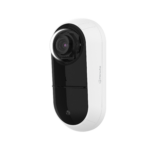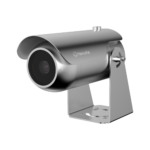2024.09.30
Rising Popularity of AI-Powered Thermal Cameras
Below, Allen DiGerolami, Business Development Manager for Data Center Solutions at Hanwha Vision America, discusses how to effectively manage security systems in data centers.

Most Data Centers Should Be Using AI-Powered Thermal Cameras
For security professionals, there is a lot to be excited about when it comes to advancements in AI-powered thermal cameras. Check out the robust security and business intelligence benefits that the latest Hanwha Vision thermal camera solutions can deliver.
Having the powerful combination of AI with thermal imaging capabilities in one camera, integrated with a powerful video management system (VMS), enables data center operators to precisely monitor equipment performance
and surrounding operating conditions (temperature, dust, heat, and more).
And, with power demands of data centers rising exponentially, ensuring the durability and performance of equipment like server stacks, networking architecture, HVAC and fire suppression systems, is essential.
Many Benefits of Using AI-Powered Thermal Cameras in Data Centers
Precise Temperature Monitoring: The ability to precisely detect and monitor temperature changes in data center equipment has never been more important.
In its most recent report, the International Energy Agency (IEA) forecasts that data centers’ total electricity consumption could reach more than 1,000 terawatt-hours (TWh) in 2026. That’s more than double the energy used to power data centers in 2022. At that time, data centers worldwide consumed 460 terawatt-hours (TWh), representing two percent of all global electricity usage.

Likewise, a recent Goldman Sachs report notes that data centers will experience a 160% rise in average energy consumptions by the end of the decade – compared to 2022 levels.
Not surprisingly, to keep up with the rising workloads, today’s data center equipment (ex. servers, storage racks, network switches, and cabling) is often operating round-the-clock at peak capacity. Temperature changes are often among the earliest warning signs of equipment overload and performance problems.
Thermal cameras are an ideal way to execute computational fluid dynamics (CFD) simulations. CFD analysis can provide insights into the thermal behavior of a data center by monitoring airflow patterns and temperature distributions, allowing engineering to evaluate the performance and durability of server-room equipment, test the efficiency of air flow from cooling units, spot any leaks from underfloor heating systems, or short circuits in cabling wires.
This information can help engineers identify areas of poor cooling and hotspots, which can help them make decisions about cooling strategies, equipment placement, and air supply. It can also ensure that potential issues are spotted before they become larger problems.
If there are immediate emergencies due to electric sparks or fire, AI thermal cameras and integrated video VMS and IP audio solutions, can trigger needed alarms, response protocols, and communications to employees.

Exceptional Image Quality – Even In Complete Darkness & At Long Ranges
Thermal cameras can complement traditional security cameras by providing exceptional visibility even in low-light conditions or complete darkness.
This is especially valuable at parking lots, and other entrances and exits, where you need to balance the detection of potential intruders or unauthorized personnel with the arrival and departure of vehicles and data center employees who work at various times throughout the day and night to support 24-7 operational needs.
AI thermal cameras can continuously monitor and analyze vast amounts of data in real-time, accurately distinguishing real threats from common causes of false alarms, such as trees, loose cables, small animals, and debris.
These systems use machine learning algorithms to detect unusual patterns and behaviors, such as unauthorized access attempts or abnormal data transfers, which could indicate a security breach. By identifying these anomalies quickly, AI can trigger immediate responses to mitigate potential threats.
This proactive approach reduces the reliance on human intervention and minimizes the risk of human error, which is often a significant factor in security breaches.
In addition, Hanwha Vision thermal cameras can deliver valuable long-range object detection, capable of identifying people and vehicles from extreme distances.
Automated Monitoring and Incident Management
AI-powered surveillance systems can automate many aspects of monitoring and incident management.
For example, they can quickly detect an unauthorized attempt to access a secure area within the data center, and automatically lock down the area, notifying security personnel, and logging the incident for further investigation.
This level of automation ensures a swift and coordinated response to potential threats, minimizing the impact on operations. Facial recognition technology, for instance, can be used to ensure that only authorized individuals gain access to sensitive areas within the data center.
Using AI-powered thermal cameras is a valuable way to bolster a company’s data center security and long-term equipment performance, ensuring that sensitive information remains secure, equipment can keep up with increasing power demands, and that your company’s assets and reputation are properly protected.
Expert Training for AI Thermal Video Surveillance Technology
Our Hanwha Vision Learning Center has multiple courses on our latest AI & Thermal camera technologies that are worth checking out. These include a comprehensive guidebook that reviews the best practices for integrating and managing thermal imaging cameras, and our latest AI-powered thermal camera offerings.


